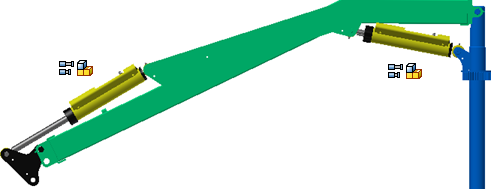About Flexible assemblies
Some assembly components need to be able to able to move to different positions in an upper level assembly. For example, a hydraulic cylinder may be used several times in the same assembly and must be free to move to represent the kinematic assembly motion. You can use Flexible to expose the allowable movement defined in the subassembly in the parent assembly. In order to accomplish this behavior, do not fully constrain the component. Instead, define relationships in the component assembly which retain the required movement.
For example, in the cylinder assembly shown in the following image, the shaft is free to move along an axis.

When the cylinder is inserted into the upper level assembly, the freedom of movement allowed in the subassembly is not exposed in the parent assembly.
To enable the Flexible status for a subassembly, right-click each instance of the component in the browser and select Flexible. The browser icon for the component changes to show Flexible is enabled.
In the following image, the cylinder is able to assume two different positions after enabling the Flexible toggle in the browser.

What are some guidelines for using flexible assemblies?
- Weldment assemblies cannot be made Flexible.
- A subassembly cannot be Flexible and Adaptive at the same time.
- Parts cannot be Flexible.
Can flexibility be used with positional representations?
Flexibility is often used in conjunction with positional representations to save an assembly in various states that can be recalled and represented in assembly modeling and drawing views.
Each instance of an assembly may be displayed in a different position, but the BOM is not affected.
How does flexible compare with adaptive in assemblies?
A component cannot be both flexible and adaptive. The states are set by options in the context menu, and can be turned on and off as needed.
Both flexible and adaptive open up the degrees of freedom available in the subassembly. However, all instances of an adaptive component, such as a cylinder, exhibit the same behavior. For example, fully extended. Each instance of a flexible cylinder can be shown in any position; fully open, fully closed, or any point in between. Flexible components can also be included in positional representations. The flexible state for each instance is stored only in the consuming assembly, not in the individual components.